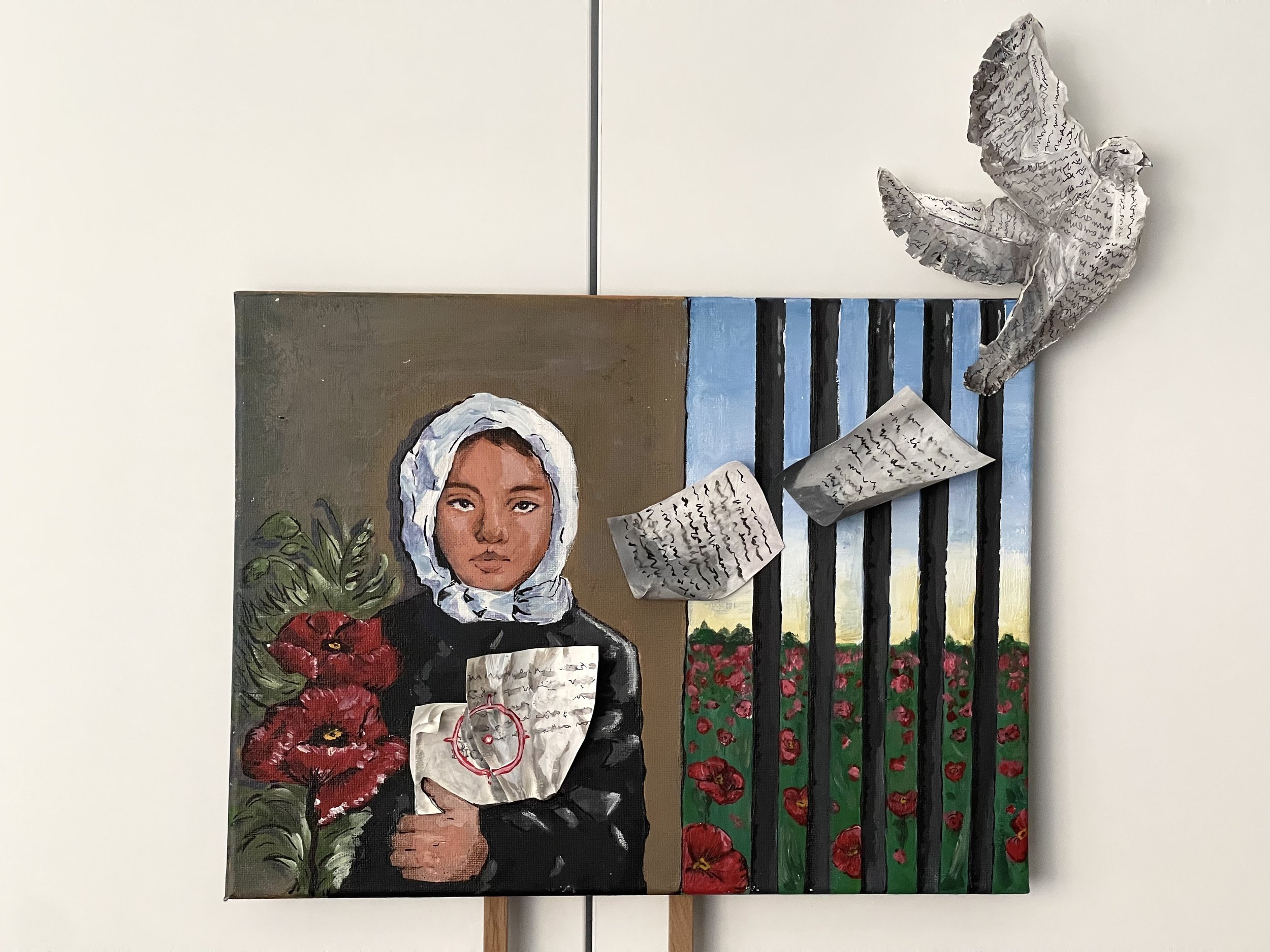aRT cREDIT: gREEN hOPE BY Wei-Zhen, 9-11, Taiwan
Peace is something that takes continuous work, but there are many ways we can prevent wars from taking place.
Some of these things we can do ourselves, or alongside our communities.
Others need to be done by our leaders.
People of every age have the ability to help prevent war.
Below you can take inspiration from some previous competition entries and find some useful prompts and links to learn more about each topic.
Please note that several of these resources are aimed at older students.
Additional materials for teachers, parents and guardians can be found at the bottom of the page.
Education
Why do you learn about conflicts at school? Do you learn about peace?
Education is vital to creating long-lasting peace: https://peacemuseum.wp.st-andrews.ac.uk/2022/05/16/education-a-force-for-sustainable-peace/
Before children that have experienced conflict can find peace, first they must unlearn war: https://peacemuseum.wp.st-andrews.ac.uk/2022/05/04/unlearning-war/
Art credit: Inaccessible Knowledge by Sally, 16-18, USA
Act with Empathy
Do you have friends or family in another country? How could these relationships help prevent wars?
This article tells the story of French rappers Bigflo and Oli, who write raps about political ideas with a focus on immigration. Click here to read more about the inspiration behind their art: https://peacemuseum.wp.st-andrews.ac.uk/2023/06/13/and-what-if-things-were-different-rapping-for-empathy/
This clothing brand was created by two Israeli and Palestinian women, who used empathy and common interests to overcome political division: https://peacemuseum.wp.st-andrews.ac.uk/2022/05/23/two-neighbors/
Art credit: The Inescapable Trauma of War by Erin, 14-16, South Korea
Imagine a Better Future
We can’t build what we haven’t imagined! Art can change our way of thinking.
What kind of future do you want to live in? How do we get there?
Here’s how your stories can change the world: https://tntlab.carterschool.gmu.edu/
Click here to read a fairytale for peace: https://vpp.wp.st-andrews.ac.uk/2024/05/19/the-little-girl-the-flowers-and-the-witch/
Art credit: Hope and Healing by Thanh Ngân, 16-18, Vietnam
Raise Awareness
Artist’s Note: ‘I want to draw attention to the situation in Afghanistan through my painting. It‘s unacceptable that women and girls don’t have the same rights as their male counterparts. I will use my voice to talk for the girls who can‘t.’
Why might raising awareness of wars help prevent them? What are some ways people raise awareness?
Peace activism can take many different forms. Learn more about some of these here: https://peacemuseum.wp.st-andrews.ac.uk/gallery/campaigning-and-activism/
Read about Shamsia Hassani - an inspirational female graffiti artist from Afghanistan: https://peacemuseum.wp.st-andrews.ac.uk/2022/04/26/a-blank-newspaper/
Art credit: Speaking For Those Who Can‘t by Rihana, 14-16, Germany
Diplomacy
Diplomacy is defined as ‘the job of dealing with the relationships between governments’.
Do you think children should have a seat at the table in rooms where decisions get made? Why or why not?
Diplomacy is more than just leaders sat around a table. Food can also play a powerful role: https://peacemuseum.wp.st-andrews.ac.uk/2024/04/18/gastrodiplomacy-food-and-culture-in-peace-making/
‘Peace does not belong to a president or a government, but to all the Colombian people’. Learn about the long road to peace in Colombia: https://peacemuseum.wp.st-andrews.ac.uk/2022/05/21/colombia-the-long-road-to-peace-after-the-civil-war-dw-documentary/
Art credit: Conference for Peace by Jian, 16-18, South Korea
Justice
How do your resolve conflicts in the classroom or at home? Does it stop them from happening again?
‘Justice’ is can be as challenging to define as ‘peace’. For some people justice can seem like revenge. Learn more here: https://vpp.wp.st-andrews.ac.uk/2024/05/01/justice-and-peace/
What is a cost worth paying for peace? This article explores how moving on from wars can be complicated: https://peacemuseum.wp.st-andrews.ac.uk/2024/04/19/peace-at-what-cost-the-amnesty-dilemma/
Art credit: No One Wins in War by Mary Jane, 16-18, USA
Breaking the Cycle
Artist’s Note: ‘I'm trying to depict how decisions made by world leaders cause destruction which come from hatred from one another. From this destruction will birth pain and suffering among the people that are affected by the destruction of their homes and people.’
What do we mean by ‘breaking the cycle’? Why might it be hard?
One woman in Rwanda broke the cycle by forgiving her husabnd’s killer. You can read her story here: https://www.bbc.co.uk/news/world-africa-61105532
Similarly to NSI, ‘In Place of War’ is a global organisation that uses creativity in places impacted by conflict and climate change as a tool for positive change. : https://www.inplaceofwar.net/ipow-homepage
Art credit: Contagious Pain by Theodore, 14-16, USA
Remembrance
How might remembering the cost of past wars and the sacrifice of previous generations help prevent future conflicts?
Shortly before his death in the First World War, Second Lieutenant Douglas Gillespie imagined a Path of Peace. This has now become a reality and is described as ‘the biggest single commemorative project underway on the globe’: https://peacemuseum.wp.st-andrews.ac.uk/2023/03/06/douglas-gillespies-path-of-peace/
Following the dropping of the first atomic bomb in 1945, Hiroshima is now seen by many as a city of peace. Its Memorial Park has a complicated history: https://peacemuseum.wp.st-andrews.ac.uk/2024/02/06/architecture-for-peace-the-hiroshima-peace-memorial-park/
Art credit: Canada Bereft by Gary, 11-14, Canada
Other Helpful Resources:
Supporting children to manage anxiety over war, conflict and crises: https://www.bps.org.uk/news/supporting-children-manage-anxiety-over-war-conflict-and-crises
Broader mental health support: https://www.mind.org.uk/for-young-people/
https://www.annafreud.org/
Healing Classrooms: https://www.rescue.org/uk/irc-uks-healing-classrooms
Peace through other means: https://peacemuseum.wp.st-andrews.ac.uk/gallery/peace-through-other-means/
Quaker peace education resources: https://www.quaker.org.uk/resources/free-resources/teaching-resources-2
Everyday Peace Indicators: https://www.everydaypeaceindicators.org/about
Our thanks to Dr Alice König at the University of St Andrews for her support with this resource.















